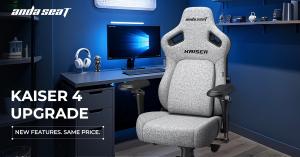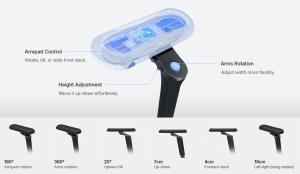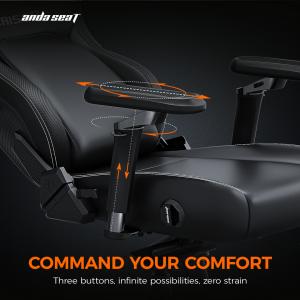
Kaiser 4 upgrade white

Kaiser 4 Upgrade 6d armrest

Kaiser 4 new 6d armrest
Andaseate defines the arm ergonomics with new 6D armrests on Kaiser 4er
Spokane, WA, United States, June 3, 2025 /Inpresswire.com/-DAS 6D Armory system from Kaiser 4, introduces new standards for functional mobility, precision and long-term arm comfort
Andaseat, a global manufacturer of ergonomic seating solutions, has officially introduced a newly developed six -dimensional armrest system as part of the upgrading Kaiser 4er. The system marks a significant leap forward from its predecessor and offers a larger area of movement, improved structural stability and more intuitive controls for long-term computer, gaming and content production tasks.
With the updated armrest system of the Kaiser 4, Andaseate deals with a core design challenge: the need for an arm support that adapts to increasingly different workflows and hybrid usage scenarios. Regardless of whether a user works on a desk, plays on a console or multitasked across several screens, the new 6D system is created in such a way that it follows the natural movement sheet of the human body and minimizes fatigue and pressure hotspots by calibrated adjustability.
The newly designed 6D armrests replace the 5D system that was found in the previous generation of Kaiser. While the previous version of height, back, left -wing and limited rotation movement made it possible, it remained briefly to offer consistent lateral flexibility and long -term position stability. The new system introduces expanded movement areas on all axes together with a precision -motored locking mechanism that eliminates the drift during active use.
Each armrest is able to achieve an 180-degree armpad rotation, which offers a significant variability of the wrist orientation. The arm unit itself revolves around 360 degrees, so that users can optimize their arm orientation based on posture, peripheral setup or activity type. In addition, the new system contains a 20-degree inclination function with which elbow compression or the positioning covered can be facilitated without reducing the forearm support.
The vertical movement is expanded to a 7-centimeter up and distance, while the setting of the depth at the front is reached to back 4 centimeters. The most important thing is that the new armrest offers 18 centimeters lateral adjustability through a rotation shift in the assembly axis – a function with which users are accommodated with different shoulder widths and work area restrictions. This area is one of the broadest in its class and is particularly relevant for ultraWide monitor users, musicians or specialists who need asymmetrical reach.
According to Lin Zhou, CEO of Andaseat, the 6D Redesign reflects a irritated understanding of what modern users expect from ARM support systems. “We no longer see any chairs than static structures. They are kinetic tools,” said Zhou. “The new armrest is not just about reach. It is about reactionability-the users intuitive, one-touch control about how their arms are positioned all day.”
The mechanical innovations will match subtle material and design considerations. The surface of the armpits contains a texturized grip canal that improves the tactile precision during the setting. This design reduces the need for users to reposition themselves physically to change the arm loading position – a small but meaningful ergonomic profit. All movement axes are reinforced using interior connections with low resistance, while the lock-in-place controls are accessible via a three-button system, which is activated with minimal pressure and audible feedback.
The Andaseat engineering team emphasized that the transition to 6d was not about increasing more degrees of freedom for novelty. Instead, the goal was to achieve every axis with a real usage. For example, rotation and inclination axes are particularly useful for musicians or digital artists who rely on custom-made their hand angles, while vertical and depth control appeal to the shoulder tension during the desk work. The lateral shift helps to maintain the neutral arm orientation in setups, which contain several monitors or unconventional keyboard placements.
The company also found that the system was tested under prolonged pressure on stability without not being perceived after repeated cycles. Last -bearing tests confirm that the armrests can support a consistent downward pressure without structural dismantling, an important requirement for longer use in fixed positions. Andaseat has not publicly announced the complete mechanical specifications or the data on the circulatory duration, but confirmed that internal test benchmarks have fulfilled or exceeded the current industry forms.
The 6D armrests are part of a wider Kaiser 4 -platform -Update, which also contains a newly designed lumbar system and updated materials in certain variants. Andaseat has intentionally isolated the armrest design as the center of its communication – an choice that underlines the role of ergonomics of the upper extremity in the brand's design priorities.
While the back support and the seat base of the chair appeal to the spine orientation and the hip pressure, the armrests deal with a different, but also critical concern: muscle load in the upper arms, forearms and wrists. The Andaseat design team pointed out to a growing group of research work, which associated the geometry of the armrest with a reduced incidence of the carpal tunnel syndrome, the shoulder pollution and the repeated movement injuries in environments with high intensity screen.
Instead of relying on conventional fixed angles or loose sliding models, the company decided on a pivot system with high stability, which maintains regardless of the Relliner angle or postponement. The armrests are constructed in such a way that they remain parallel to the seat of the seated user, regardless of whether upright, forward or in semi-sampling positions. This ensures that the pressure on the ulnar side of the wrist and the elbow is consistently distributed regardless of the posture.
In contrast to many conventional stool structures, in which armrests are designed as peripheral support structures, the 6D system from Andaseat treats them as a primary interface. This change in the design hierarchy is intended to reflect the way people actually use their chairs today – without static platforms and more than adaptive workstations.
For users who switch between desktop and console inputs or switch between productivity and game modes, the 6D system offers a position memory without relying on digital default settings. As soon as they are locked up, each axis remains set until they are deliberately set. This mechanical memory reduces the cognitive burden associated with repositioning, and enables users to maintain a consistent ergonomic basis during different activity types.
Although Andaseat has not announced any plans to offer the 6D system as a retrofitting option for previous Kaiser models, the company stated that the modularity remains a long-term consideration of designs. The 6D armrests are currently only available in the Kaiser 4 series and are integrated directly into the frame architecture, whereby third-party providers are retrofitted under current assembly methods.
The Kaiser 4 Series with 6D armrests are now available via the direct sales platform from Andaseat and authorized global distributors. Users who are interested in examining the area of adjustability and ergonomic configurations can be displayed on the company's website.
Andaseat plans to continue research and development in relation to adaptive ARM systems, whereby the ongoing user data recording informs future updates. Since hybrid work and longer screen time are further embedded in daily life, the company sees the support of the upper extremity as a critical border in stool design.
“It is easy to see ergonomic chairs mainly to see the spine,” said Zhou. “But what we learn is that small changes in the armrest can have cascading effects on shoulder keeping, back load and even mental focus. That is why we took this challenge seriously.”
About Andaseat
Andaseat is a provider of Global Seating Solutions that specializes in ergonomic furniture that was developed for the use of extended screens. The company was originally an OEM supplier for automotive seats and has developed into a brand of direct-to-consumer with core offers in home office, eSports and hybrid professional environments. The design philosophy of Andaseat focuses on evidence, modular construction and certified safe materials. The Kaiser series introduced in 2016 is still the best -known line of the company.
Further information about the Kaiser 4 series or the 6D armrest system can be found at Andaseat.com.
Caroline Chen
Andaseat
+86 139 2232 2347
Send us an e -mail here
Visit us on social media:
LinkedIn
Instagram
Facebook
YouTube
Tiktok
X
Exclusion:
A presswire offers this news content “What is” without guarantee of any kind. We do not assume any responsibility or liability for the correctness, content, images, videos, licenses, completeness, legality or reliability of the information contained in this article. If you have complaints or copyright problems related to this article, please contact the author mentioned above.

